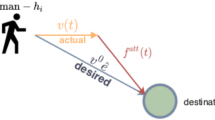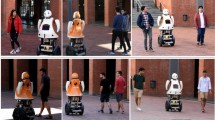Abstract
Robots are now operating in workspaces occupied by humans and the robots often need to avoid people while travelling to their desired goal. Humans follow some navigation conventions while walking, called as social cues, like avoiding an oncoming person from the left. It is important for the robots to display the same social cues to be socially accepted by the humans. Current works in social robot motion planning are limited to maintenance of a socially compliant distance. This paper exhibits a socialistic behavior of a robot avoiding an oncoming human by the preferred side. This paper extends the social force model to incorporate the social cues by adding new social forces. The paper also extends the geometric approach to incorporate the social cues by selecting the geometric gap as per the social preference. Finally, we propose a novel hybrid approach combining the social potential field and geometric method, wherein the preferred gap for navigation adds a new social force to the robot. The proposed approach maintains the proactive nature of the geometric approach as well as retains the reactive nature of the social force model. The hybrid method maintains a larger clearance and generates safer trajectories as compared to the baseline social potential field and follow the gap methods. The experiments are done with the Pioneer LX robot using vision cameras and a lidar for navigation operating at the Centre of Intelligent Robotics at IIIT Allahabad.

















Similar content being viewed by others
References
Breazeal C, Dautenhahn K, Kanda T (2016) Social robotics. In: Siciliano B, Khatib O (eds) Springer handbook of robotics. Springer handbooks. Springer, Cham
Alač M, Movellan J, Tanaka F (2011) When a robot is social: spatial arrangements and multimodal semiotic engagement in the practice of social robotics. Soc Stud Sci 41(6):893–926
Weiss A, Bader M, Vincze M, Hasenhütl G, Moritsch S (2014) Designing a service robot for public space: an action and experiences-approach. In: Proceedings of the 2014 ACM/IEEE international conference on human–robot interaction, 2014
Tsuda N, Harimoto S, Saitoh T, Konishi R (2009) Mobile robot with following and returning mode. In: The 18th IEEE international symposium on robot and human interactive communication, Toyama, pp 933–938
Shiomi M, Kanda T, Glas DF, Satake S, Ishiguro H, Hagita N (2009) Field trial of networked social robots in a shopping mall. In: 2009 IEEE/RSJ international conference on intelligent robots and systems, St. Louis, MO, pp 2846–2853
Bera A, Randhavane T, Prinja R, Manocha D (2017) SocioSense: Robot navigation amongst pedestrians with social and psychological constraints. In: 2017 IEEE/RSJ international conference on intelligent robots and systems (IROS), Vancouver, BC, pp 7018–7025
Burgoon JK, Jones SB (1976) Toward a theory of personal space expectations and their violations. Hum Commun Res 2(2):131–146
Pandey AK, Alami R (2010) A framework towards a socially aware mobile robot motion in human-centered dynamic environment. In: 2010 IEEE/RSJ international conference on intelligent robots and systems, pp 5855–5860
Kala R, Warwick K (2013) Motion planning of autonomous vehicles in a non-autonomous vehicle environment without speed lanes. Eng Appl Artif Intell 26(5–6):1588–1601
Gopinath D, Jain S, Argall BD (2017) Human-in-the-loop optimization of shared autonomy in assistive robotics. IEEE Robot Autom Lett 2(1):247–254
Schirner G, Erdogmus D, Chowdhury K, Padir T (2013) The future of human-in-the-loop cyber-physical systems. Computer 46(1):36–45
Ferrer G, Garrell A, Sanfeliu A (2013) Robot companion: a social force based approach with human awareness-navigation in crowded environments. In: IEEE/RSJ international conference on intelligent robots and systems, pp 1688–1694
Sisbot EA, Marin-Urias LF, Alami R, Simeon T (2007) A human aware mobile robot motion planner. IEEE Trans Robot 23(5):874–883
Helbing D, Molnar P (1995) Social force model for pedestrian dynamics. Phys Rev E 51(5):4282
Reif J, Wang H (1995) Social potential fields: a distributed behavioral control for autonomous robots. In: International workshop on algorithmic foundations of robotics, AK Peters, Wellesley, MA, USA, pp 431–459
Sezer V, Gokasan M (2012) A novel obstacle avoidance algorithm: follow the gap method. Robot Auton Syst 60(9):1123–1134
Kala R (2018) Routing-based navigation of dense mobile robots. Intell Serv Robot 11(1):25–39
Murphy R (2000) The hybrid deliberative/reactive paradigm. In: Murphy R (ed) Introduction to AI robotics, 2nd edn. MIT Press, Cambridge
Knepper RA, Rus D (2012) Pedestrian-inspired sampling-based multi-robot collision avoidance. In: IEEE international symposium on robot and human interactive communication, pp 94–100
van den Berg J, Lin M, Manocha D (2008) Reciprocal velocity obstacles for real-time multi-agent navigation. In: Proceedings of the IEEE international conference on robotics and automation, pp 1928–1935
van den Berg, J, Guy, SJ, Lin, M, Manocha, D (2011) Reciprocal n-body collision avoidance. In: Pradalier C, Siegwart R, Hirzinger G (eds) Robotics research. Springer tracts in advanced robotics, vol 70. Springer, Berlin. https://doi.org/10.1007/978-3-642-19457-3_1
Zhang D, Xie Z, Li P, Yu J, Chen Z (2015) Real-time navigation in dynamic human environments using optimal reciprocal collision avoidance. In: International conference on mechatronics, pp 2232–2237
Repiso E, Garrell A, Sanfeliu A (2019) Adaptive side-by-side social robot navigation to approach and interact with people. Int J Soc Robot. https://doi.org/10.1007/s12369-019-00559-2
Demir M, Sezer V (2017) Improved follow the gap method for obstacle avoidance. In: IEEE international conference on advanced intelligent mechatronics, pp 1435–1440
Ozdemir A, Sezer V (2018) Follow the gap with dynamic window approach. Int J Semant Comput 12(1):43–57
Borenstein J, Koren Y (1991) The vector field histogram-fast obstacle avoidance for mobile robots. IEEE Trans Robot Autom 7(3):278–288
Ulrich I, Borenstein J (1998) VFH + : reliable obstacle avoidance for fast mobile robots. In: Proceedings of the 1998 IEEE international conference on robotics and automation, pp 1572–1577
Ulrich I, Borenstein J (2000) VFH/sup*: local obstacle avoidance with look-ahead verification. In: Proceedings of the 2000 international conference on robotics and automation, pp 2505–2511
Khatib O (1985) Real-time obstacle avoidance for manipulators and mobile robots. In: Proceedings of the IEEE international conference on robotics and automation, vol 2, pp 500–505
Ferrer G, Garrell A, Sanfeliu A (2013) Social-aware robot navigation in urban environment. In: European conference on mobile robots, pp 331–336
Zanlungo F, Ikeda T, Kanda T (2011) Social force model with explicit collision prediction. Europhys Lett 93:68005
Shiomi M, Zanlungo F, Hayashi K, Kanda T (2014) Towards a socially acceptable collision avoidance for a mobile robot navigating among pedestrians using a pedestrian model. Int J Soc Robot 6(3):443–455
Takahashi M, Suzuki T, Cinquegrani F, Sorbello R, Pagello E (2009) A mobile robot for transport applications in hospital domain with safe human detection algorithm. In: 2009 IEEE international conference on robotics and biomimetics, pp 1543–1548
Görür OC, Erkmen AM (2014) Elastic networks in reshaping human intentions by proactive social robot moves. In: The 23rd IEEE international symposium on robot and human interactive communication, pp 1012–1017
Truong XT, Ngo TD (2017) Toward socially aware robot navigation in dynamic and crowded environments: a proactive social motion model. IEEE Trans Autom Sci Eng 14(4):1743–1760
Ratsamee P, Mae Y, Ohara K, Takubo T, Arai T (2013) Human–robot collision avoidance using a modified social force model with body pose and face orientation. Int J Humanoid Robot 10(01):1350008
Luber M, Spinello L, Silva J, Arras KO (2012) Socially-aware robot navigation: a learning approach. In: 2012 IEEE/RSJ international conference on intelligent robots and systems, pp 902–907
Long P, Liu W, Pan J (2017) Deep-learned collision avoidance policy for distributed multiagent navigation. IEEE Robot Autom Lett 2(2):656–663
Khare A, Motwani R, Akash S, Patil J, Kala R (2018) Learning the goal seeking behaviour for mobile robots. In: 2018 3rd Asia-Pacific conference on intelligent robot systems, pp 56–60
Chen YF, Liu M, Everett M, How JP (2017) Decentralized non-communicating multiagent collision avoidance with deep reinforcement learning. In: 2017 IEEE international conference on robotics and automation, pp 285–292
Everett M, Chen YF, How JP (2018) Motion planning among dynamic, decision-making agents with deep reinforcement learning. In: 2018 IEEE/RSJ international conference on intelligent robots and systems, pp 3052–3059
Chen YF, Everett M, Liu M, How JP (2017) Socially aware motion planning with deep reinforcement learning. In: 2017 IEEE/RSJ international conference on intelligent robots and systems, pp 1343–1350
Abbeel P, Ng AY (2004) Apprenticeship learning via inverse reinforcement learning. In: Proceedings of the twenty-first international conference on machine learning. ACM
Ng AY, Russell SJ (2000) Algorithms for inverse reinforcement learning. In: Proceedings of the international conference on machine learning, p 2
Kim B, Pineau J (2015) Socially adaptive path planning in human environments using inverse reinforcement learning. Int J Soc Robot 8(1):51–66
Kretzschmar H, Spies M, Sprunk C, Burgard W (2016) Socially compliant mobile robot navigation via inverse reinforcement learning. Int J Robot Res 35(11):1289–1307
Truong XT, Ngo TD (2016) Dynamic social zone based mobile robot navigation for human comfortable safety in social environments. Int J Soc Robot 8(5):663–684
Paliwal SS, Kala R (2018) Maximum clearance rapid motion planning algorithm. Robotica 36(6):882–903
Kruse T, Pandey AK, Alami R, Kirsch A (2013) Human-aware robot navigation: a survey. Robot Auton Syst 61(12):1726–1743
Schroff F, Kalenichenko D, Philbin J (2015) Facenet: a unified embedding for face recognition and clustering. In: Proceedings of the IEEE conference on computer vision and pattern recognition, pp 815–823
Zhang K, Zhang Z, Li Z, Qiao Y (2016) Joint face detection and alignment using multitask cascaded convolutional networks. IEEE Signal Process Lett 23(10):1499–1503
Quigley M, Gerkey B, Conley K, Faust J, Foote F, Leibs J, Berger E, Wheeler R, Ng A (2009) ROS: an open-source robot operating system. In: ICRA workshop on open source software, vol 3, no 3.2, p 5
Reddy AK, Malviya V, Kala R. Video results. https://www.youtube.com/watch?v=JZt-798I7cw&list=PLWKZs3S5723nUEENFte7pvHRO49YIm8Tj
Acknowledgements
This work is supported by the Science and Engineering Research Board, Department of Science and Technology, Government of India vide research grant ECR/2015/000406 and the Indian Institute of Information Technology, Allahabad, India. The authors wish to thank Abhinav Malviya for his help in recording and analysis of the socialistic behaviors used in this study.
Author information
Authors and Affiliations
Corresponding author
Ethics declarations
Conflict of interest
The authors have no conflict of interest to declare.
Additional information
Publisher's Note
Springer Nature remains neutral with regard to jurisdictional claims in published maps and institutional affiliations.
Rights and permissions
About this article
Cite this article
Reddy, A.K., Malviya, V. & Kala, R. Social Cues in the Autonomous Navigation of Indoor Mobile Robots. Int J of Soc Robotics 13, 1335–1358 (2021). https://doi.org/10.1007/s12369-020-00721-1
Accepted:
Published:
Issue Date:
DOI: https://doi.org/10.1007/s12369-020-00721-1




